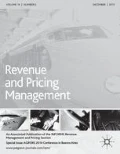Abstract
High demand uncertainties, long production lead times, and short product life cycles cause high risks for supply chain planning in the semiconductor industry. These affect all industries producing goods containing semiconductors. We present a robust supply chain planning framework for revenue management that consists of stable and flexible solutions for demand steering and dynamic pricing, extending current industry practice in several aspects. We introduce the concept of availabilities and capabilities, as well as various planning processes and process enablers. Based on our framework, we also highlight directions for future research.


Similar content being viewed by others
References
Adida, E. and Perakis, G. (2010) Dynamic pricing and inventory control: Robust vs. stochastic uncertainty models – a computational study. Annals of Operations Research 181(1): 125–157.
Anderson, T.W. and Darling, D.A. (1954) A test of goodness of fit. Journal of the American Statistical Association 49(268): 765–769.
Armstrong, J. (1985) Long Range Forecasting: From Crystal Ball to Computer. New York: Wiley.
Bergeron, D. (2008) ‘More than Moore’, Proceedings of the 2008 IEEE Custom Integrated Circuits Conference (CICC), San Jose, CA, 21–24 September.
Chen, C.-Y., Zhao, Z.-Y. and Ball, M.O. (2001) Quantity and due date quoting available to promise. Information Systems Frontiers 3(4): 477–488.
Chen, C.-Y., Zhao, Z. and Ball, M.O. (2002) A model for batch advanced available-to-promise. Production and Operations Management 11(4): 424–440.
Chien, C.-F., Wu, J.-Z. and Wu, C.-C. (2013) A two-stage stochastic programming approach for new tape-out allocation decisions for demand fulfillment planning in semiconductor manufacturing. Flexible Services and Manufacturing Journal 25(3): 286–309.
Christou, I. and Ponis, S. (2009) A hierarchical system for effective coordination of available-to-promise logic mechanisms. International Journal of Production Research 47(11): 3063–3078.
Costantino, F., Di Gravio, G., Shaban, A. and Tronci, M. (2015) A real-time SPC inventory replenishment system to improve supply chain performances. Expert Systems with Applications 42(3): 1665–1683.
Davizón, Y.A., de J Lozoya, J. and Soto, R. (2010) ‘Demand Management in Semiconductor Manufacturing: A Dynamic Pricing Approach Based on Fast Model Predictive Control,’ Proceedings of the 2010 IEEE Electronics, Robotics and Automotive Mechanics Conference (CERMA), Cuernavaca, Mexico: IEEE, 28 September–1 October 2010.
Gallego, G., Katircioglu, K. and Ramachandran, B. (2006) Semiconductor inventory management with multiple grade parts and downgrading. Production Planning and Control 17(7): 689–700.
Gallego, G. and Stefanescu, C. (2009) Upgrades, upsells and pricing in revenue management, 28 January, http://papers.ssrn.com/sol3/papers.cfm?abstract_id=1334341, accessed 21 March 2015.
Gallego, G. and Talebian, M. (2012) Demand learning and dynamic pricing for multi-version products. Journal of Revenue and Pricing Management 11(3): 303–318.
Gallego, G. and Van Ryzin, G. (1994) Optimal dynamic pricing of inventories with stochastic demand over finite horizons. Management Science 40(8): 999–1020.
Huang, K. (2005) ‘Multi-stage stochastic programming models in production planning’, Ph.D. thesis, Georgia Institute of Technology, Atlanta, GA.
Huefner, R.J. and Largay, J.A. (2013) Identifying revenue opportunities via capacity analysis. Journal of Revenue and Pricing Management 12(4): 305–312.
Karabuk, S. and Wu, S.D. (2003) Coordinating strategic capacity planning in the semiconductor industry. Operations Research 51(6): 839–849.
Kilger, C. and Meyr, H. (2015) Demand fulfillment and ATP. In: H. Meyr, C. Kilger, H. Stadtler (eds.) Supply Chain Management and Advanced Planning. Berlin: Springer, pp. 177–194.
Lee, H.L., Padmanabhan, V. and Whang, S. (2004) Information distortion in a supply chain: The bullwhip effect. Management Science 50(12): 1875–1886.
Massey, F.J. (1951) The Kolmogorov–Smirnov test for goodness of fit. Journal of the American Statistical Association 46(253): 68–78.
Moore, G.E. (1965) Cramming more components onto integrated circuits. Electronics 38(8): 114–117.
Ott, H.C., Heilmayer, S. and Sng, C.S.Y. (2013) Granularity dependency of forecast accuracy in semiconductor industry. Research in Logistics and Production 3(1): 49–58.
Pibernik, R. (2005) Advanced available-to-promise: Classification, selected methods and requirements for operations and inventory management. International Journal of Production Economics 93: 239–252.
Talluri, K.T. and Van Ryzin, G.J. (2004) The Theory and Practice of Revenue Management. New York: Springer.
Talluri, K.T., Van Ryzin, G.J., Karaesmen, I.Z. and Vulcano, G.J. (2008) ‘Revenue management: models and methods’, Proceedings of the 40th Conference on Winter Simulation, Miami, FL: Miami: Winter Simulation Conference, 7–10 December.
WSTS Inc. (2015) World semiconductor trade statistics, 23 February, https://www.wsts.org/, accessed 08 April, 2015.
Wu, A., Chiang, D. and Chang, C.-W. (2010) Using order admission control to maximize revenue under capacity utilization requirements in MTO B2B industries. Journal of the Operations Research Society of Japan 53(4): 270–288.
Zhang, F., Roundy, R., Cakanyildirim, M. and Huh, W.T. (2004) Optimal capacity expansion for multi-product, multi-machine manufacturing systems with stochastic demand. IIE Transactions 36(1): 23–36.
Zhao, Z., Ball, M.O. and Kotake, M. (2005) Optimization-based available-to-promise with multi-stage resource availability. Annals of Operations Research 135(1): 65–85.
Author information
Authors and Affiliations
Corresponding author
Rights and permissions
About this article
Cite this article
Seitz, A., Ehm, H., Akkerman, R. et al. A robust supply chain planning framework for revenue management in the semiconductor industry. J Revenue Pricing Manag 15, 523–533 (2016). https://doi.org/10.1057/s41272-016-0068-7
Revised:
Published:
Issue Date:
DOI: https://doi.org/10.1057/s41272-016-0068-7




